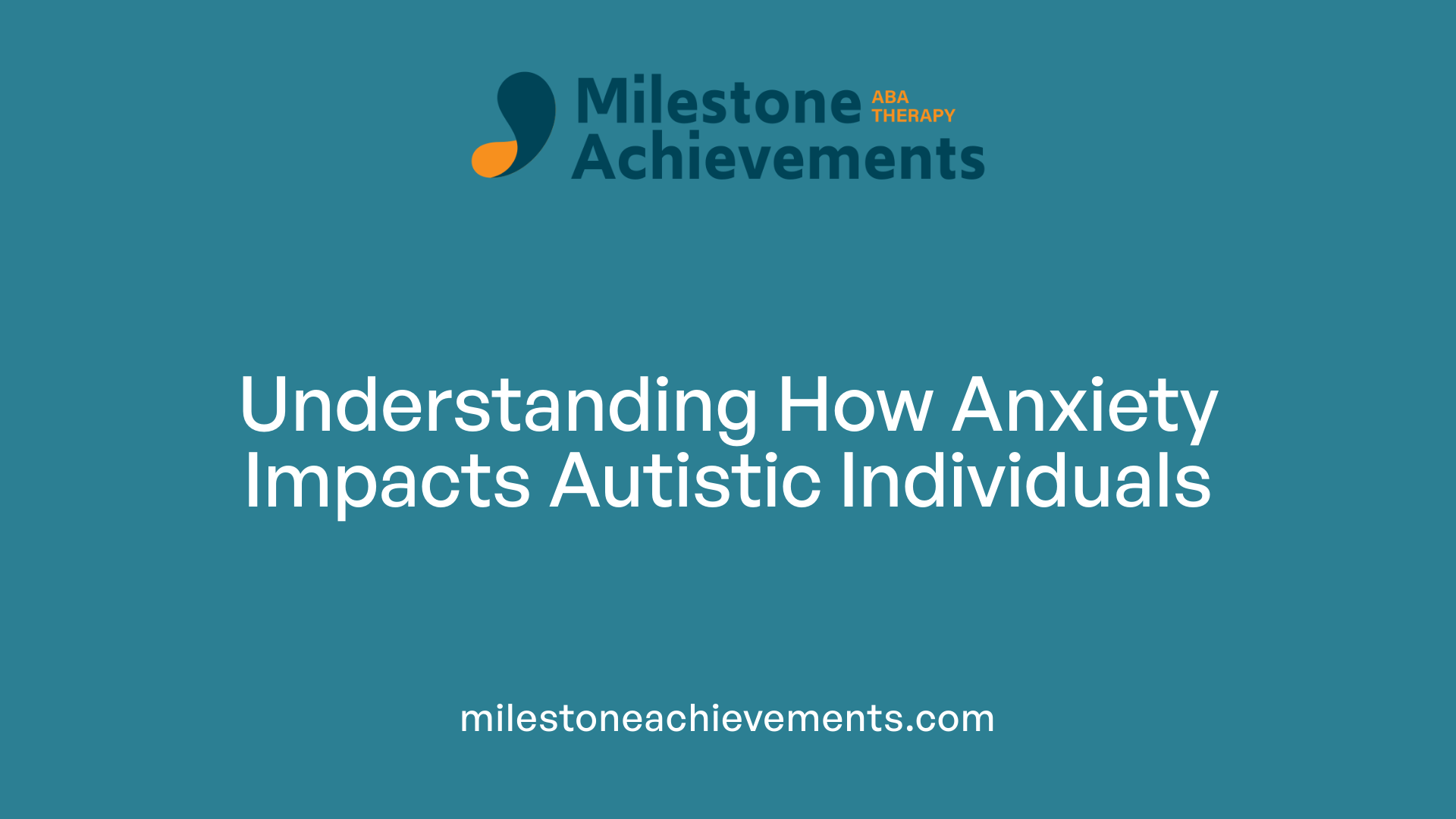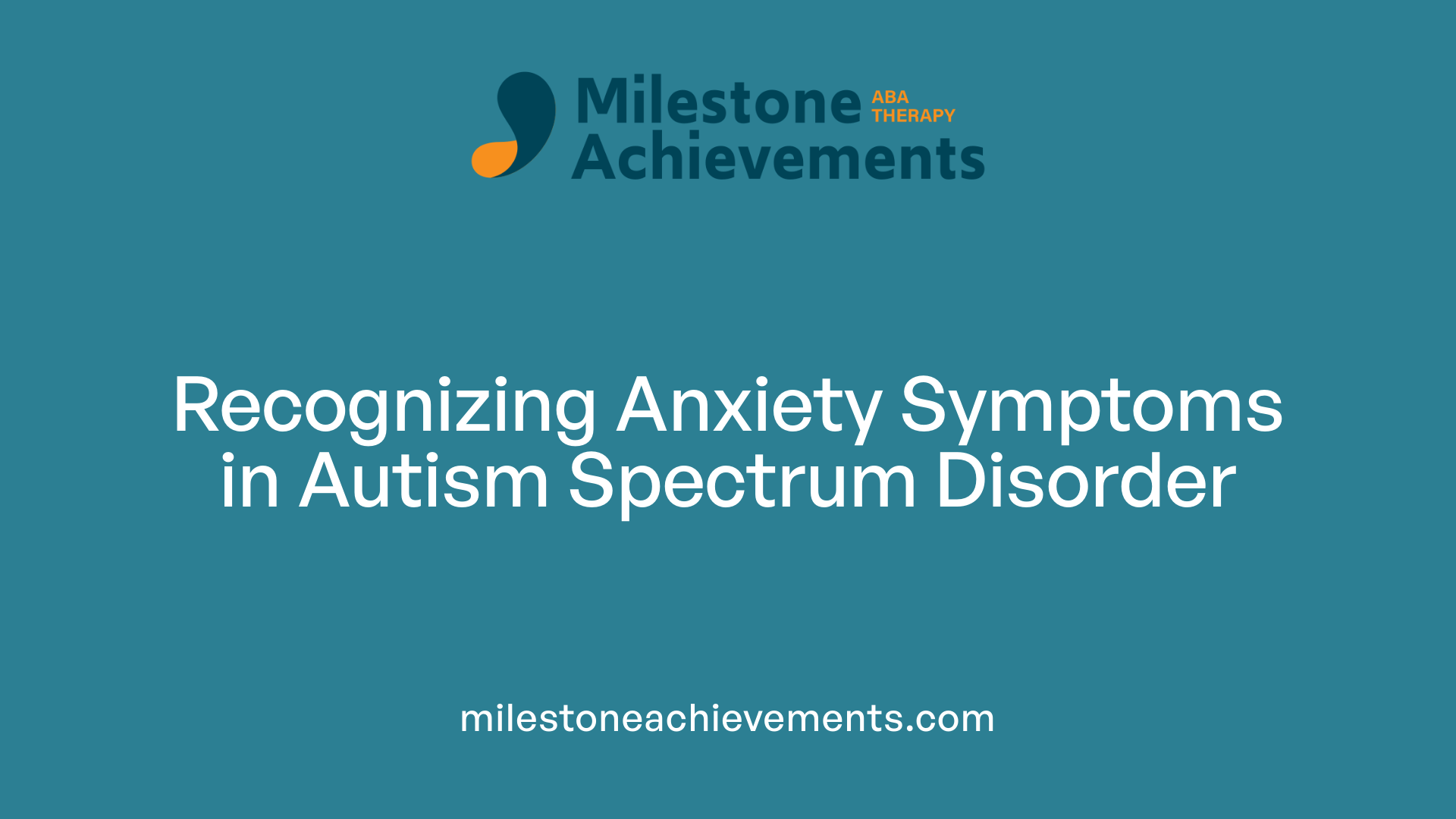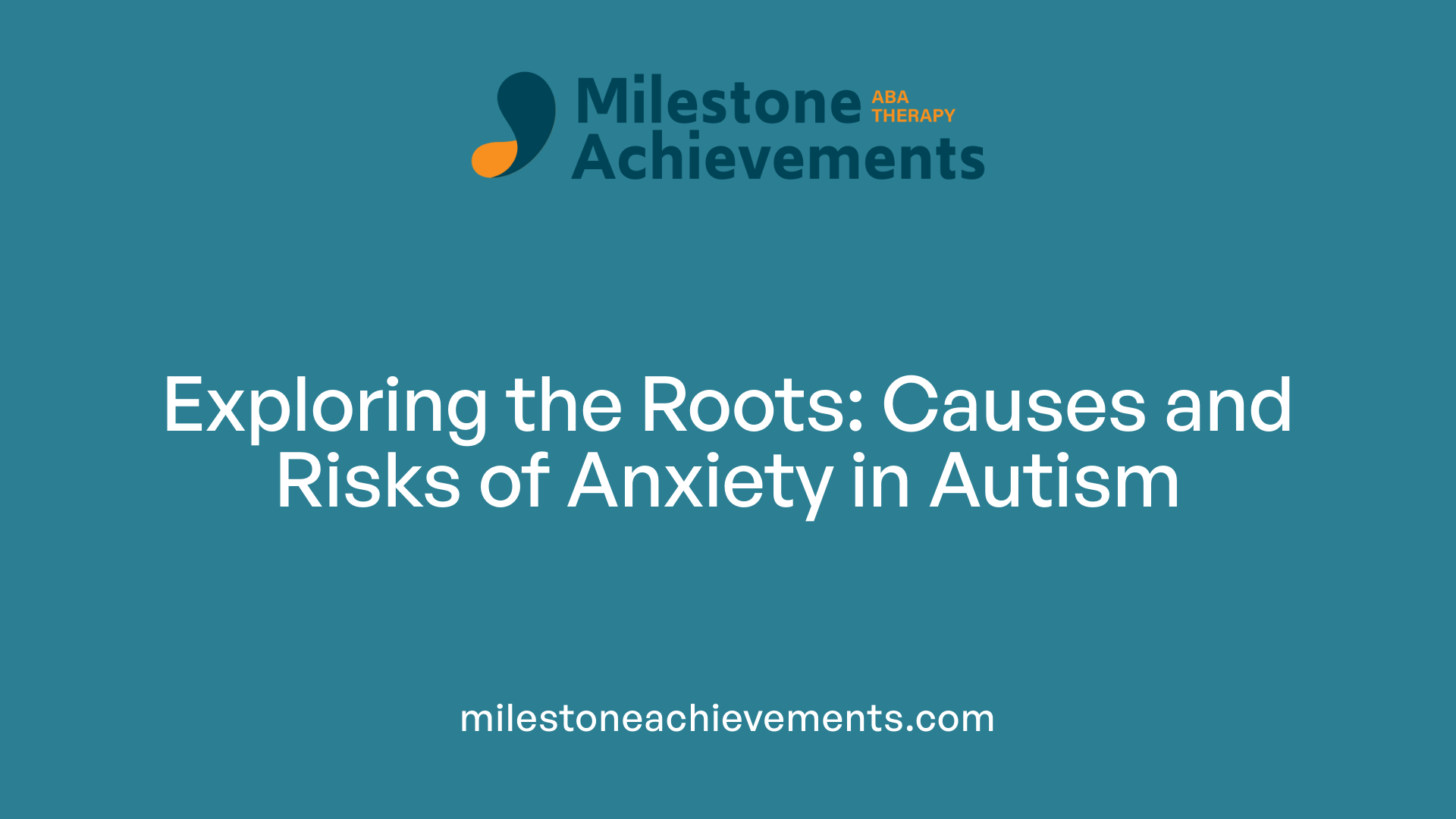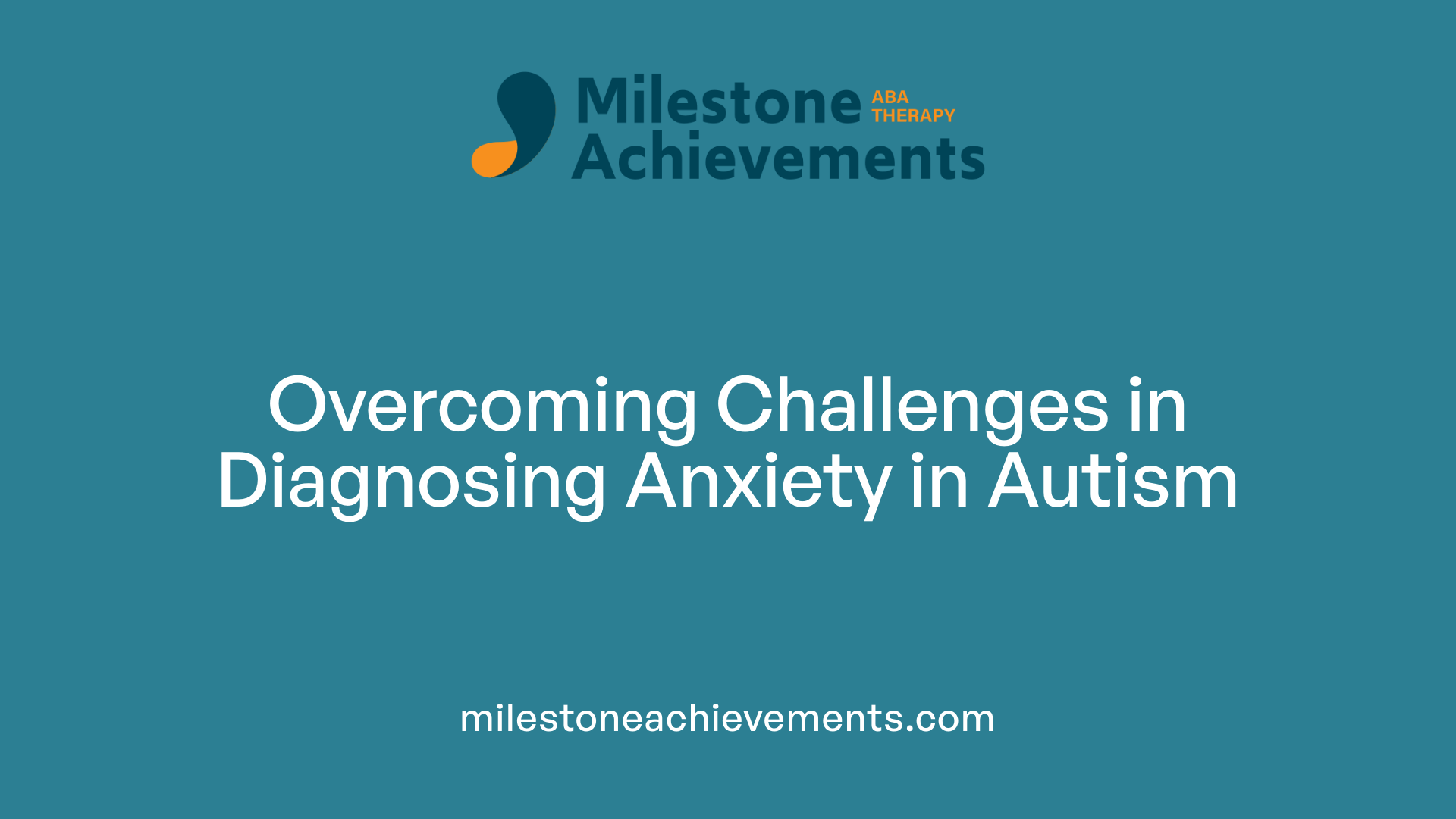
The Connection Between Autism and Anxiety Disorders
Unraveling the Complex Relationship Between Autism and Anxiety
Understanding the Overlap and Its Implications
The intersection of autism spectrum disorder (ASD) and anxiety disorders is a significant area of concern in neurodevelopmental and mental health research. While anxiety is not a core feature of autism, its prevalence among autistic individuals is remarkably high, impacting various life domains. This article explores the multifaceted connection between autism and anxiety, including their shared symptoms, underlying causes, assessment challenges, and effective management strategies.
Prevalence and Co-Occurrence of Autism and Anxiety
 Research shows that anxiety disorders are highly common in both children and adults with autism spectrum disorder (ASD). Studies indicate that approximately 40% of children with autism experience some form of anxiety, while the prevalence in adults is around 50%. This overlap includes specific conditions like phobias, obsessive-compulsive disorder (OCD), and social anxiety disorder, which are especially prevalent.
Research shows that anxiety disorders are highly common in both children and adults with autism spectrum disorder (ASD). Studies indicate that approximately 40% of children with autism experience some form of anxiety, while the prevalence in adults is around 50%. This overlap includes specific conditions like phobias, obsessive-compulsive disorder (OCD), and social anxiety disorder, which are especially prevalent.
The significant co-occurrence of autism and anxiety has profound effects on daily functioning. Anxiety can intensify core autism symptoms, such as repetitive behaviors, resistance to change, and sensory sensitivities. It often leads to behaviors including panic attacks, avoidance, meltdowns, self-injury, and social withdrawal. These challenges can impair communication, hinder learning and employment opportunities, and reduce overall quality of life.
The high rates of anxiety underscore the importance of routine screening and personalized interventions. Early identification and tailored treatment approaches—like behavioral therapies and supportive strategies—are crucial for improving outcomes for autistic individuals. Recognizing the pervasive nature of anxiety in this population and addressing it proactively can significantly enhance their well-being and adaptive functioning.
Symptoms and Clinical Features of Anxiety in Autism

What are the symptoms and clinical features of anxiety in individuals with autism?
Anxiety in autistic individuals can present through a range of behavioral and physical signs. Common behavioral indicators include increased repetitive actions such as counting, checking, tapping, or sticking to rigid routines. These behaviors often serve as coping mechanisms but can also be signs of underlying anxiety.
Children and adults may display irritability, mood swings, or episodes of distress that are difficult to attribute solely to autism. Sleep disturbances and appetite changes are also frequent, often worsening during heightened anxiety episodes.
Physiologically, signs of anxiety include a racing heart rate, rapid breathing, trembling, sweating, feeling sick, and chest tightness. These symptoms indicate autonomic nervous system activation, which may be hard to observe directly but are crucial clues for caregivers and clinicians.
Due to the overlap of anxiety symptoms with autism core traits, it can be challenging to distinguish between anxiety-driven behaviors and typical autism behaviors. This is especially true in minimally verbal or very young children, where communication difficulties hinder accurate assessment.
Are there unique ways in which anxiety manifests in autistic individuals?
Yes, anxiety may manifest uniquely in people on the autism spectrum. Elevated routines and rituals become more prominent, with individuals possibly engaging in behaviors like excessive checking or strict adherence to routines to reduce uncertainty.
Avoidance of social situations can also be a prominent sign, often driven by fear of judgment or difficulty interpreting social cues—though sometimes mistaken as mere disinterest. Sensory-seeking behaviors or heightened sensitivity to sensory stimuli, such as sounds or textures, may increase during anxious periods.
Additionally, stress might lead to more intense stimming, a common autism self-regulation behavior, which could be misinterpreted if not viewed through the context of anxiety. Recognizing these patterns is essential in appropriately addressing anxiety without confusing it with usual autism features.
Causes and Risk Factors Linking Autism and Anxiety

What are the risk factors linking autism and anxiety disorders?
Shared genetic predispositions are a significant factor in the connection between autism and anxiety. Studies show that siblings of autistic individuals have higher rates of anxiety, suggesting a genetic overlap. Neurodevelopmental differences, such as heightened sensory sensitivities and difficulties processing social cues, contribute further. These challenges can lead to increased frustration, social withdrawal, and heightened stress levels.
Environmental influences also play a role. Social pressures, routine disruptions, and a lack of adequate support can exacerbate anxiety symptoms in autistic individuals. Additionally, comorbid conditions like depression and obsessive-compulsive disorder (OCD) often heighten overall difficulty, creating a complex interplay of risk factors.
How do biological factors influence anxiety in autism?
Biological research points to structural differences in the brain, particularly the amygdala, which is involved in fear and emotional regulation. Variations in the growth and connectivity of the amygdala during critical developmental periods may contribute to increased anxiety in autistic individuals.
Genetic studies show potential overlaps between autism and other psychiatric conditions, emphasizing the biological basis of these comorbidities. Altered neural pathways and brain chemistry can influence how anxiety manifests, making some individuals more prone to heightened fear responses and emotional dysregulation.
Understanding these biological underpinnings helps highlight the importance of early assessment and personalized interventions, focusing on both neurological and environmental factors to manage anxiety effectively in autism.
Assessment and Diagnosis Challenges

How is anxiety assessed and diagnosed in autistic individuals?
Assessing anxiety in people with autism involves a tailored, multi-faceted approach. Clinicians often use a combination of specialized interviews, caregiver reports, and direct behavior observation. Tools like the Anxiety Scale for Children - ASD (ASC-ASD) have been developed specifically for autistic populations, enhancing detection accuracy. Structured interviews such as the Autism-specific adaptations of the Anxiety Disorders Interview Schedule (ADIS) are also employed.
However, multiple challenges complicate diagnosis. Overlapping symptoms—such as repetitive behaviors stemming from autism or distress caused by sensory sensitivities—can mask or mimic anxiety. Communication difficulties, particularly in minimally verbal individuals, make self-reporting unreliable. These factors necessitate a comprehensive evaluation that combines physiological measures, behavioral observations, and informant insights to accurately identify anxiety.
What difficulties are encountered in diagnosing anxiety among people with autism?
Diagnosing anxiety in autistic individuals is complicated by several factors. Overlap of autism core symptoms with anxiety manifestations, like irritability or heightened sensory responses, can lead to misinterpretation. Repetitive or ritualistic behaviors might be viewed as autism traits rather than signs of underlying anxiety.
Moreover, existing assessment tools may lack validation specifically for autistic populations, reducing their effectiveness. Heavy reliance on parent or caregiver reports introduces subjectivity, which can be problematic, especially when caregivers lack awareness of anxiety symptoms.
In individuals with limited verbal ability or intellectual disabilities, recognizing emotional distress becomes even harder. These challenges highlight the importance of using a variety of assessment methods, including behavioral observations, physiological measurements, and structured, autism-adapted questionnaires, to improve diagnostic accuracy.
Treatment Options and Management Strategies
What are effective treatment options and management strategies for anxiety in autistic individuals?
Addressing anxiety in those with autism spectrum disorder (ASD) often involves a multi-faceted approach. One of the most effective psychological interventions is modified cognitive-behavioral therapy (CBT). Traditional CBT is adapted with visual supports, concrete language, and active involvement of caregivers to meet the communication and sensory needs of autistic individuals. Incorporating special interests into therapy sessions can also enhance engagement and reduce anxiety.
In addition to therapy, environmental adjustments play a vital role. Visual schedules, social stories, and structured routines help create predictability, which can significantly diminish feelings of uncertainty and stress. Relaxation techniques such as deep breathing, mindfulness adapted for autism, and sensory-based interventions can help manage physiological arousal.
Medication options are sometimes considered, primarily selective serotonin reuptake inhibitors (SSRIs), but they must be used with caution. The evidence for pharmacological treatments specific to ASD is limited, and side effects can be more pronounced. Therefore, medication is typically combined with behavioral strategies and closely monitored by health professionals.
Addressing sensory sensitivities and promoting coping skills through a multidisciplinary team can improve overall functioning. Creating a supportive environment that reduces stressors and fosters self-regulation is crucial in managing anxiety effectively.
Are there specific challenges in applying standard anxiety treatments to autistic populations?
Applying conventional anxiety treatments like standard CBT presents certain challenges for autistic individuals. Communication differences and sensory sensitivities require significant modifications to traditional protocols. For example, some autistic individuals might respond better to visual or hands-on interventions rather than verbal cognitive strategies.
Caregiver involvement becomes even more essential, as they help generalize skills outside therapy sessions and support environmental adjustments. Structuring sessions with concrete, predictable activities and incorporating special interests can increase engagement.
Furthermore, medication use requires careful consideration. The potential for side effects and limited autism-specific research mean clinicians must monitor responses closely and use pharmacology as a complementary tool rather than a standalone solution.
Overall, tailored interventions that respect the unique needs and strengths of autistic individuals improve treatment outcomes and help reduce anxiety symptoms effectively.
Unique Challenges in Recognizing Anxiety in Autism
What are the unique challenges involved in identifying anxiety in autistic populations?
Recognizing anxiety in individuals with autism presents several hurdles. One of the main issues is the significant overlap of symptoms between autism and anxiety disorders. For example, behaviors like repetitive movements, avoidance, or tantrums might reflect core autism traits such as inflexibility or sensory sensitivities, rather than external anxiety.
Communication difficulties further complicate diagnosis. Many autistic individuals, especially those who are minimally verbal, may struggle to express their feelings or fears clearly. This makes it hard for clinicians and caregivers to differentiate whether behaviors are autistic traits, signs of anxiety, or both.
Additionally, the lack of widely validated, autism-specific assessment tools hinders accurate diagnosis. Traditional anxiety questionnaires and interviews may not fully capture the physiological or behavioral signs of anxiety in this population. For example, physiological indicators like increased heart rate may be difficult to observe or interpret.
Consequently, clinicians often need to rely on comprehensive evaluation techniques. These include multimodal assessment strategies such as detailed behavioral observations, physiological measurements when possible, and input from caregivers who know the individual well. Recognizing the nuanced presentation of anxiety in autism requires a careful, individualized approach.
How can clinicians improve diagnosis accuracy for anxiety in autism?
To enhance diagnostic precision, clinicians should employ tailored assessment tools like the Anxiety Scale for Children – Autism Spectrum Disorder (ASC-ASD). Combining multiple sources of information—including behavioral descriptions, physiological data, and caregiver reports—can also improve accuracy.
Training clinicians to distinguish between typical autism behaviors and signs of anxiety is vital. For instance, understanding that reassurance-seeking and ritualistic behaviors could be anxiety-driven rather than solely autism-related helps clarify diagnosis.
Ongoing research into developing and validating autism-specific diagnostic tools remains essential. These advancements, along with continued training and awareness, will support improved recognition and treatment of anxiety in autistic individuals.
Current Research and Future Directions

What does current research reveal about the connection between autism and anxiety disorders?
Recent studies highlight that anxiety disorders are highly prevalent among individuals with autism. It is estimated that nearly half of all autistic people experience some form of anxiety, with specific conditions like social phobia, specific phobias, and generalized anxiety disorder being common. Neurobiological research suggests that differences in brain regions such as the amygdala, which is involved in fear response, play a role in this overlap. Structural and functional variations in the amygdala, along with atypical brain connectivity patterns, may contribute to heightened anxiety symptoms. Behavioral studies indicate that anxiety can exacerbate core autism traits, such as inflexibility, sensory sensitivities, and social challenges, creating a cycle that worsens overall functioning. Promising interventions like modified cognitive-behavioral therapy (CBT) tailored for autism show some effectiveness, but ongoing research is focused on understanding the complex biological and psychological interplay to improve treatments.
What are the gaps and future directions in understanding autism-related anxiety?
Despite significant progress, several gaps remain in current knowledge. There is a need for more precise prevalence data across different age groups and diverse populations. Development and validation of autism-specific diagnostic tools for anxiety are crucial to ensure accurate identification, especially in minimally verbal or intellectually disabled individuals. Research into the genetic and neurodevelopmental mechanisms underlying co-occurring anxiety and autism continues to be a priority. Advanced brain imaging and genetic studies may reveal new targets for intervention. Furthermore, there is an urgent call for long-term, randomized controlled trials to assess the efficacy of pharmacological treatments tailored for autistic individuals, as current medications are not specifically approved or proven effective in this population. Personalized approaches, combining biological markers with behavioral profiles, could facilitate individualized treatments. Growing emphasis is being placed on early identification and intervention to mitigate the impact of anxiety on development and improve quality of life. Overall, interdisciplinary research bridging neuroscience, genetics, clinical psychology, and behavioral science holds promise for advancing understanding and care for anxiety in autism.
The Path Forward in Addressing Anxiety in Autism
As awareness of the high prevalence and complex nature of anxiety in individuals with autism grows, it becomes increasingly important to refine assessment techniques and tailor treatments to this population's unique needs. Emphasizing early intervention, comprehensive evaluation, and multidisciplinary approaches can significantly improve outcomes. Continued research into underlying biological mechanisms and the development of autism-specific therapies holds promise for reducing the burden of anxiety, enhancing social and emotional wellbeing, and supporting a higher quality of life for autistic individuals across the lifespan.
References
- Autism and Anxiety - Autism Research Institute
- Anxiety and autism | What is autism? - Autistica
- Comorbid autism spectrum disorder and anxiety disorders: a brief ...
- Anxiety in Autism Spectrum Disorder
- Anxiety in Autism Spectrum Disorder: Clinical Characteristics and ...
- Autism and Anxiety: Similarities and Differences - Healthline
- Anxiety disorders and autism | Autism Speaks


Partner with us on your child's journey
Milestone Achievements offers evidence-based ABA therapy to help children with autism reach their full potential. Together we’ll set meaningful goals and celebrate progress every step of the way.
Start ABA Services Today


